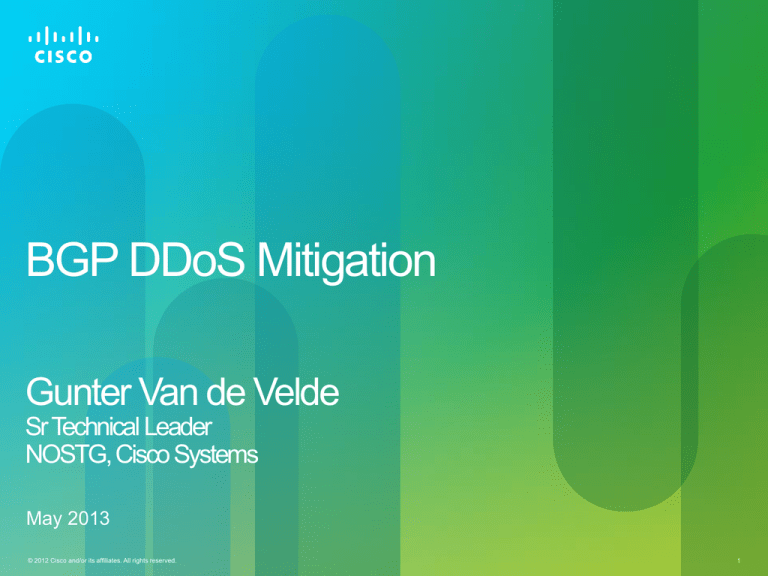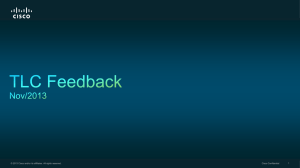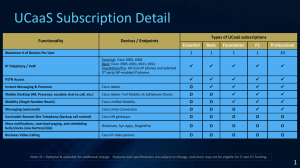
BGP DDoS Mitigation
Gunter Van de Velde
SrTechnical Leader
NOSTG, Cisco Systems
May 2013
© 2012 Cisco and/or its affiliates. All rights reserved.
1
A simple DDoS mitigation
mechanism explained
Bertrand Duvivier, bduvivie@cisco.com
Gunter Van de Velde, gvandeve@cisco.com
© 2012 Cisco and/or its affiliates. All rights reserved.
Cisco Public
DDoS Mitigation Adoption Cycle
Phase III
o
Dynamic application aware redirection and traffic handling
Phase II
o
Malicious traffic mitigation
o
Cleaning of Malicious traffic
o
Dirty and clean traffic handling
o
Usage of Multi-instance BGP
Phase I
o
ACL
o
RTBH
o
PBR
o
uRPF
© 2012 Cisco and/or its affiliates. All rights reserved.
Cisco Public
DDoS Overview
Distributed denial-of-service (DDoS) attacks target network
infrastructures or computer services by sending overwhelming
number of service requests to the server from many sources.
Server resources are used up in serving the fake requests
resulting in denial or degradation of legitimate service requests
to be served
Addressing DDoS attacks
Detection – Detect incoming fake requests
Mitigation
Diversion – Send traffic to a specialized device that removes the fake packets from the traffic
stream while retaining the legitimate packets
Return – Send back the clean traffic to the server
© 2012 Cisco and/or its affiliates. All rights reserved.
Cisco Public
DDOS impact on Customer Business
© 2012 Cisco and/or its affiliates. All rights reserved.
Cisco Public
DDOS impact on customer Business
Enterprise customer can’t defend themselve, when
DDoS hit the FW… it’s already too late.
SP could protect enterprise by cleaning DDoS traffic at
ingress peering point.
New revenue for SP.
Mandated service to propose to Financial and visible
customers.
© 2012 Cisco and/or its affiliates. All rights reserved.
Cisco Public
DDoS mitigation architecture
1. Detection (no DDoS)
Scan Netflow data
to detect DDOS attacks
Security
Server
DDOS
Analyser
Sample
Netflow
DDOS
scrubber
© 2012 Cisco and/or its affiliates. All rights reserved.
Cisco Public
DDoS mitigation architecture
2. Detection (DDOS)
Scan Netflow data
Find DDOS signature
Security
Server
DDOS
Analyser
Sample
Netflow
DDOS
scrubber
© 2012 Cisco and/or its affiliates. All rights reserved.
Cisco Public
DDoS mitigation architecture
3. Redirect traffic to DDOS scruber
Scan Netflow data
Find DDoS signature
DDoS
Analyser
Security
Server
BGP DDoS Mitigation
Action: redirect to DDoS scrubber
DDoS
scrubber
© 2012 Cisco and/or its affiliates. All rights reserved.
Cisco Public
The concept
Traffic under normal conditions
Traffic under normalized conditions
•
•
Traffic takes shortest path
Upstream and downstream traffic
follow traditional routing
ALL interfaces are in the GLOBAL
routing table
•
Server
Scrubber
Pre-provisioned DDoS instrumentation
PE2
PE3
•
•
Security analyser
Security server
ISP
PE1
•
Traffic Scrubber
Separate clean and malicious traffic
Security Analyser
Analyses Netflow/IPFIX statistics from
the traffic flows
Security server
Actions upon traffic analysis by
communication to infrastructure
routers
Internet users
© 2012 Cisco and/or its affiliates. All rights reserved.
Cisco Public
12
Phase-1: Traditional DDoS mitigation
Traffic under DDoS condition - RTBH
Traffic under DDoS condition
•
Server
Scrubber
PE2
•
•
PE3
•
•
Security analyser
Security server
•
ISP
Security analyser detected that the
traffic flow is dirty
Security server installs a filter upon ISP
ingress router
All (good and malicious) traffic is
dropped at network ingress
Operationally simple method
Easy to remove filter if traffic
normalizes
Simple to debug and troubleshoot
PE1
Internet users
© 2012 Cisco and/or its affiliates. All rights reserved.
Cisco Public
13
Phase-2: BGP based DDoS
Traffic under DDoS condition
Traffic under DDoS condition
•
•
•
Server
Scrubber
Traffic is redirected to a scrubber
Scrubber separates the clean from the
malicious traffic
Clean traffic is returned to original
destination server
PE2
PE3
Goal
•
•
•
•
Security analyser
Security server
ISP
PE1
Do not drop all traffic
Collect traffic intelligence
Operational simplicity
Easy to remove redirect when traffic
normalizes
Internet users
14
© 2012 Cisco and/or its affiliates. All rights reserved.
Cisco Public
How does it work?
Normal traffic condition
Internet and VPN
Route-Reflector
•
•
5.5.5.5
Server
Scrubber
2.2.2.2
3.3.3.3
•
•
All PE’s peer with the RR
All PE’s exchange both Global Internet
and VPN prefixes
All PE interfaces are non-VPN
Security analyser is performing doing
analyses
PE2
PE3
1.1.1.1/32
Security analyser
Security server
ISP
4.4.4.4
PE1
Destination
Next-hop
1.1.1.1/32
2.2.2.2
Internet users
© 2012 Cisco and/or its affiliates. All rights reserved.
Cisco Public
15
How does it work?
Server is under DDoS
Internet and VPN
Route-Reflector
•
5.5.5.5
•
•
Server
Scrubber
2.2.2.2
Flow is detected as dirty by Security
analyser
Result: Server is under attack
Traffic needs to be redirected to the
scrubber to mitigate the attack
3.3.3.3
PE2
PE3
1.1.1.1/32
Security analyser
Security server
ISP
4.4.4.4
PE1
Destination
Next-hop
1.1.1.1/32
2.2.2.2
Internet users
© 2012 Cisco and/or its affiliates. All rights reserved.
Cisco Public
16
How does it work?
Server is under DDoS
Internet and VPN
Route-Reflector
DDoS
Route-Reflector
5.5.5.5
5.5.5.5
Destination
Next-hop
1.1.1.1/32
3.3.3.3
Server
Scrubber
2.2.2.2
3.3.3.3
PE2
PE3
1.1.1.1/32
Security server
•
•
ISP
4.4.4.4
PE1
•
DDoS Route-Reflector was pre-visioned
Mitigation route to 1.1.1.1/32 is
injected on the DDoS RR by the Security
server
Mitigation route to 1.1.1.1/32 is
pointing to 3.3.3.3 on DDoS mitigation
RR
Internet users
© 2012 Cisco and/or its affiliates. All rights reserved.
Cisco Public
17
How does it work?
Server is under DDoS
Internet and VPN
Route-Reflector
DDoS
Route-Reflector
5.5.5.5
5.5.5.5
Destination
Next-hop
1.1.1.1/32
3.3.3.3
•
•
Server
Scrubber
2.2.2.2
•
3.3.3.3
PE2
PE3
1.1.1.1/32
•
Mitigation route to 1.1.1.1/32 is
pointing to 3.3.3.3 is signalled to all
PE’s
All PE’s receive the mitigation route
from the DDoS Mitigation RR
Each PE will now have 2 routes to reach
1.1.1.1/32
Which route will the PE use?
Security server
ISP
4.4.4.4
PE1
BGP Table
Internet users
Destinatio
n
Next-hop
1.1.1.1/32
2.2.2.2
1.1.1.1/32
3.3.3.3
© 2012 Cisco and/or its affiliates. All rights reserved.
Routing Table
Destination
Next-hop
1.1.1.1/32
?????????
???
Cisco Public
18
How does it work?
Server is under DDoS
Trick # 1
Internet and VPN
Route-Reflector
DDoS
Route-Reflector
5.5.5.5
5.5.5.5
•
Server
Scrubber
2.2.2.2
The DDoS mitigation route will
ALWAYS be preferred, even if
• Both prefix lengths are the same
• DDoS prefix is shorter
• Original prefix has better
administrative distance
3.3.3.3
PE2
PE3
1.1.1.1/32
Security server
ISP
4.4.4.4
PE1
BGP Table
Internet users
Destinatio
n
Next-hop
1.1.1.1/32
2.2.2.2
1.1.1.1/32
3.3.3.3
© 2012 Cisco and/or its affiliates. All rights reserved.
Routing Table
Destination
Next-hop
1.1.1.1/32
3.3.3.3
Cisco Public
19
Problem
•
•
How does it work?
Server is under DDoS
•
•
Internet and VPN
Route-Reflector
DDoS
Route-Reflector
5.5.5.5
5.5.5.5
Clean
traffic
Server
Scrubber
2.2.2.2
3.3.3.3
PE2
PE3
1.1.1.1/32
Scrubber sends traffic to PE3
PE3 does routing lookup for 1.1.1.1 and
finds that it is directly attached
ROUTING LOOP!!!
How do we fix this?
• Often this is fixed with true
routing clutches:
• Back-to-back cables
• L2-VPN’s
• Manual tunnels
• Etc… (all operational hard to
maintain)
• Better to use a new isolated
dynamic routing table for the
clean traffic
• Pre-provision this Clean table
ISP
4.4.4.4
PE1
BGP Table
Internet users
Destinatio
n
Next-hop
1.1.1.1/32
2.2.2.2
1.1.1.1/32
3.3.3.3
© 2012 Cisco and/or its affiliates. All rights reserved.
Routing Table
Destination
Next-hop
1.1.1.1/32
3.3.3.3
Cisco Public
21
How does it work?
Server is under DDoS
•
•
•
•
Server
Scrubber
2.2.2.2
The clean traffic will be injected upon
PE3 on an interface member of VPN
Clean
PE3 will now do a routing destination
lookup for 1.1.1.1 in VPN Clean
The matching routing table entry is
pointing towards PE2 at 2.2.2.2
The clean flow, which is now part of
VPN Clean is sent towards PE2
reachable at 2.2.2.2
3.3.3.3
PE2
PE3
1.1.1.1/32
ISP
4.4.4.4
PE1
BGP Table
Internet users
VPN Clean
Routing Table
Destinatio
n
Next-hop
Destinatio
n
Next-hop
VPN
1.1.1.1/32
2.2.2.2
1.1.1.1/32
3.3.3.3
Global
1.1.1.1/32
3.3.3.3
1.1.1.1/32
2.2.2.2
Clean
© 2012 Cisco and/or its affiliates. All rights reserved.
Cisco Public
22
How does it work?
Server is under DDoS
Routing Table
•
Destinatio
n
Next-hop
VPN
•
1.1.1.1/32
3.3.3.3
Global
•
1.1.1.1/32
CE1
Clean
•
PE2 receives the clean flow within
VPN clean
PE2 does a destination address
routing lookup in VPN clean
A matching route is found in VPN
clean
Flow is forwarded towards CE1
onwards to Server
Server
Scrubber
2.2.2.2
3.3.3.3
CE1
PE2
PE3
1.1.1.1/32
HOLD on a minute!
ISP
4.4.4.4
PE1
PE2 does not have any interface part of VPN clean
All interfaces on PE2 are global interfaces
so how did that clean route for 1.1.1.1 get into VPN clean?
Internet users
23
© 2012 Cisco and/or its affiliates. All rights reserved.
Cisco Public
How does it work?
Server is under DDoS
Routing Table
BGP Table
Destinati
on
Nexthop
VPN
Destinatio
n
Next-hop
VPN
1.1.1.1/32
CE1
Global
1.1.1.1/32
3.3.3.3
Global
1.1.1.1/32
3.3.3.
3
Global
1.1.1.1/32
CE1
Clean
1.1.1.1
CE1
clean
Trick # 2
Server
Scrubber
2.2.2.2
3.3.3.3
CE1
PE2
•
•
PE3
1.1.1.1/32
•
ISP
4.4.4.4
PE1
•
•
Copy the locally BGP inserted route
directly into VPN clean BGP table
Neighbour details are inherited from the
global table (i.e.)
• Outgoing interface
• Next-hop
Interface pointing towards CE1 is NOT
VPN aware
This VPN clean distributed as normal
VPN
New CLI command to do that
import from default-vrf route-policy ddos advertise-as-vpn
Internet users
24
© 2012 Cisco and/or its affiliates. All rights reserved.
Cisco Public
Going back to traditional traffic flow
DDoS attack has ended
Internet and VPN
Route-Reflector
DDoS
Route-Reflector
5.5.5.5
5.5.5.5
Destination
Next-hop
1.1.1.1/32
3.3.3.3
Server
Scrubber
2.2.2.2
3.3.3.3
•
•
1.1.1.1/32
•
Remove the routing entry on the
Mitigation DDoS RR
No more route is remaining on the
DDoS Mitigation RR
Traffic flows normally again
Security server
ISP
4.4.4.4
PE1
Internet users
© 2012 Cisco and/or its affiliates. All rights reserved.
Cisco Public
25
Why injecting DDoS in separate BGP instance ?
Solution support redirection of BGP less/more specific prefixes or
local originated prefixes (static route, redistributed route)
Indepenant Inter-Domain control plane and DDoS plane
No need to withdraw and re-signal Inter-Domain prefixes, keep
internet route intacts in control plane.
Easy to troubleshoot
© 2012 Cisco and/or its affiliates. All rights reserved.
Cisco Public
Any Questions?
© 2012 Cisco and/or its affiliates. All rights reserved.
Cisco Public
BRKRST-3371
© 2012 Cisco and/or its affiliates. All rights reserved.
Cisco Public
Backup Slides
Technical details
© 2012 Cisco and/or its affiliates. All rights reserved.
Cisco Public
Configuration (1)
Creation of DDoS BGP instance
router bgp 99 instance ddos
bgp router-id 3.3.3.3
bgp read-only
bgp install diversion
address-family ipv4 unicast
!
Allows config of 2th IPv4 or IPv6 instance
Suppresses BGP Update Generation
router bgp 99
bgp router-id 2.2.2.2
address-family ipv4 unicast
!
Triggers BGP ddos instance to install diversion
path to RIB, so that the paths are pushed down to
FIB
© 2012 Cisco and/or its affiliates. All rights reserved.
Cisco Public
Configuration (2)
Importing the global route’s in the clean VRF
vrf clean
address-family ipv4 unicast
import from default-vrf route-policy ddos advertise-as-vpn
export route-target
111:1
!
!
address-family ipv6 unicast
import from default-vrf route-policy ddos advertise-as-vpn
export route-target
111:1
!
!
!
© 2012 Cisco and/or its affiliates. All rights reserved.
Cisco Public
“show” commands
RP/0/0/CPU0:hydra-prp-A#show route
Codes: C - connected, S - static, R - RIP, B - BGP, (>) - Diversion path
D - EIGRP, EX - EIGRP external, O - OSPF, IA - OSPF inter area
N1 - OSPF NSSA external type 1, N2 - OSPF NSSA external type 2
E1 - OSPF external type 1, E2 - OSPF external type 2, E - EGP
i - ISIS, L1 - IS-IS level-1, L2 - IS-IS level-2
ia - IS-IS inter area, su - IS-IS summary null, * - candidate
default
U - per-user static route, o - ODR, L - local, G - DAGR
A - access/subscriber, a - Application route, (!) - FRR Backup
path
Gateway of last resort is not set
O
O
L
O
O
1.0.11.0/24 [110/2] via 13.0.3.1, 00:36:19, GigabitEthernet0/2/1/5
1.1.1.1/32 [110/2] via 13.0.3.1, 00:36:19, GigabitEthernet0/2/1/5
2.2.2.2/32 is directly connected, 00:37:24, Loopback0
3.3.3.3/32 [110/2] via 87.0.1.2, 00:36:19, GigabitEthernet0/2/1/9
4.4.4.4/32 [110/3] via 13.0.3.1, 00:36:19, GigabitEthernet0/2/1/5
[110/3] via 87.0.1.2, 00:36:19, GigabitEthernet0/2/1/9
B
5.5.5.5/32 [200/0] via 1.1.1.1, 00:34:22
B > [200/0] via 123.0.0.2, 00:34:22
[...]
© 2012 Cisco and/or its affiliates. All rights reserved.
Cisco Public
“show” commands (1)
RP/0/0/CPU0:hydra-prp-A#show route
Codes: C - connected, S - static, R - RIP, B - BGP, (>) - Diversion path
D - EIGRP, EX - EIGRP external, O - OSPF, IA - OSPF inter area
N1 - OSPF NSSA external type 1, N2 - OSPF NSSA external type 2
E1 - OSPF external type 1, E2 - OSPF external type 2, E - EGP
i - ISIS, L1 - IS-IS level-1, L2 - IS-IS level-2
ia - IS-IS inter area, su - IS-IS summary null, * - candidate
default
U - per-user static route, o - ODR, L - local, G - DAGR
A - access/subscriber, a - Application route, (!) - FRR Backup path
Gateway of last resort is not set
O
O
L
O
O
B
[...]
1.0.11.0/24 [110/2] via 13.0.3.1, 00:36:19, GigabitEthernet0/2/1/5
1.1.1.1/32 [110/2] via 13.0.3.1, 00:36:19, GigabitEthernet0/2/1/5
2.2.2.2/32 is directly connected, 00:37:24, Loopback0
3.3.3.3/32 [110/2] via 87.0.1.2, 00:36:19, GigabitEthernet0/2/1/9
4.4.4.4/32 [110/3] via 13.0.3.1, 00:36:19, GigabitEthernet0/2/1/5
[110/3] via 87.0.1.2, 00:36:19, GigabitEthernet0/2/1/9
5.5.5.5/32 [200/0] via 1.1.1.1, 00:34:22
B > [200/0] via 123.0.0.2, 00:34:22
© 2012 Cisco and/or its affiliates. All rights reserved.
Cisco Public
“show” commands (2)
RP/0/0/CPU0:hydra-prp-A#show route 5.5.5.5/32
Routing entry for 5.5.5.5/32
Known via "bgp 2394-ro", distance 200, metric 0, type internal
Installed Feb 19 22:56:45.896 for 00:34:33
Routing Descriptor Blocks
1.1.1.1, from 1.1.1.1
Route metric is 0
123.0.0.2, from 101.0.0.4, Diversion Path (bgp)
Route metric is 0
No advertising protos.
RP/0/0/CPU0:hydra-prp-A#show cef 5.5.5.5/32 det
5.5.5.5/32, version 60652, internal 0x14000001 (ptr 0xaf6e3840) [1], 0x0 (0x0), 0x0 (0x0)
Updated Feb 19 22:56:46.723
local adjacency 87.0.1.2
Prefix Len 32, traffic index 0, precedence n/a, priority 4
gateway array (0xae07a310) reference count 2, flags 0x8020, source rib (5), 0 backups
[1 type 3 flags 0xd0141 (0xae10f8c0) ext 0x420 (0xaec261e0)]
LW-LDI[type=0, refc=0, ptr=0x0, sh-ldi=0x0]
via 123.0.0.2, 2 dependencies, recursive [flags 0x6000]
path-idx 0 [0xaf6e3c00 0x0]
next hop 123.0.0.2 via 123.0.0.0/24
Load distribution: 0 (refcount 1)
Hash
0
OK
Y
Interface
GigabitEthernet0/2/1/9
Address
87.0.1.2
© 2012 Cisco and/or its affiliates. All rights reserved.
Cisco Public
“show” commands (3)
RP/0/0/CPU0:hydra-prp-A# show route 123.0.0.2
Routing entry for 123.0.0.0/24
Known via "ospf 100", distance 110, metric 2, type intra area
Installed Feb 19 22:54:48.363 for 00:39:01
Routing Descriptor Blocks
87.0.1.2, from 3.3.3.3, via GigabitEthernet0/2/1/9
Route metric is 2
No advertising protos.
RP/0/0/CPU0:hydra-prp-A#
RP/0/0/CPU0:hydra-prp-A#show route 1.1.1.1
Routing entry for 1.1.1.1/32
Known via "ospf 100", distance 110, metric 2, type intra area
Installed Feb 19 22:54:49.259 for 00:49:20
Routing Descriptor Blocks
13.0.3.1, from 1.1.1.1, via GigabitEthernet0/2/1/5
Route metric is 2
No advertising protos.
© 2012 Cisco and/or its affiliates. All rights reserved.
Cisco Public
© 2012 Cisco and/or its affiliates. All rights reserved.
36







